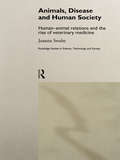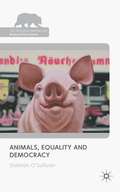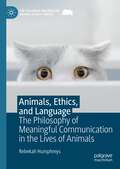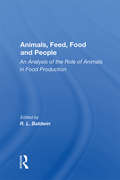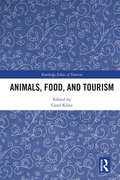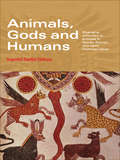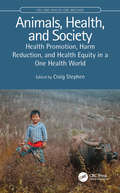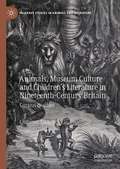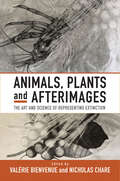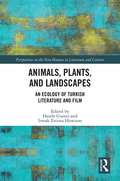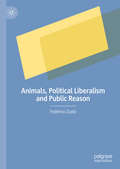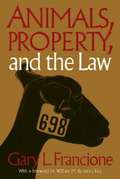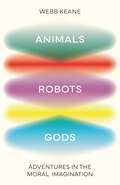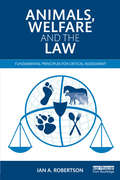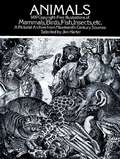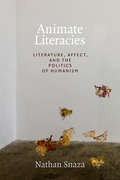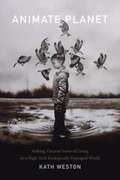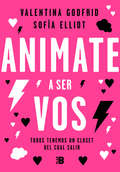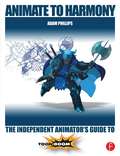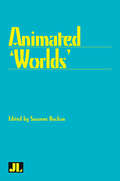- Table View
- List View
Animals, Disease and Human Society: Human-animal Relations and the Rise of Veterinary Medicine (Routledge Studies in Science, Technology and Society #No.2)
by Joanna SwabeThis book explores the history and nature of our dependency on other animals and the implications of this for human and animal health. Writing from an historical and sociological perspective, Joanna Swabe's work discusses such issues as:* animal domestication* the consequences of human exploitation of other animals, including links between human and animal disease* the rise of a veterinary regime, designed to protect humans and animals alike* implications of intensive farming practices, pet-keeping and recent biotechnological developments.This account spans a period of some ten thousand years, and raises important questions about the increasing intensification of animal use for both animal and human health.
Animals, Empathy, and Anthropomorphism: The Limits of Imagination (The Palgrave Macmillan Animal Ethics Series)
by Carlo SalzaniThis open access book explores the role of imagination in animal ethics and its constitutive links to empathy/sympathy and anthropomorphism. The book argues for the constitutive role of imagination in ethical deliberation, but acknowledges that there exist important limits to its use. However, &“limit&” is here understood not merely negatively as restriction and insufficiency, but rather positively as &“condition of possibility,&” so what the book explores and analyses are the conditions for a positive and fruitful use of the imagination in ethics. The book uses as a &“frame&” the questions and issues raised in J.M. Coetzee&’s The Lives of Animals to explore some central and salient themes.
Animals, Equality and Democracy (The Palgrave Macmillan Animal Ethics)
by Siobhan O’SullivanAnimals, Equality and Democracy examines the structure of animal protection legislation and finds that it is deeply inequitable, with a tendency to favour those animals the community is most likely to see and engage with. Siobhan O'Sullivan argues that these inequities violate fundamental principle of justice and transparency.
Animals, Ethics and Trade: The Challenge of Animal Sentience
by Joyce D'Silva Jacky TurnerModern urban life cuts us off from direct connection with the animal world, yet daily the lives of millions of animals are affected by what we consume and wear and what we trade in. The use of animals for food, labour and pleasure pursuits has long been justified with the assumption that unlike humans, animals aren't fully sentient beings. In recent years, however, science has revealed an astonishing array of complex animal behaviour, and scientists and policy makers now accept that the animals we make use of are indeed conscious, with preferences and intentions. The implications for our culture of factory farming, fast food and rainforest liquidation are staggering. In this powerful book, internationally renowned experts on animal behaviour and agriculture such as Jane Goodall, Tim Lang and Vandana Shiva are brought together with ethicists, religious scholars, international industry and regulators for the first time to debate these critical issues and tackle the profound implications of animal sentience. ? The first sections discuss scientific and ethical perspectives on the consciousness, emotions and mental abilities of animals. Later sections address how human activities such as science, law, religion, farming, food production, trade, development and education respect or ignore animals' sentience and welfare, and review the options for changes in our policies, our practices and our thinking. The result is nothing less than a stark and necessary look into the heart of humanity and the ethics that govern our animal powered society.
Animals, Ethics, and Language: The Philosophy of Meaningful Communication in the Lives of Animals (The Palgrave Macmillan Animal Ethics Series)
by Rebekah HumphreysWith an ever-growing body of evidence on the links between different oppressions, never have the debates in Critical Animal Studies surrounding intersectionality in relation to animal ethics been more important. In particular, the arguments related to anthropomorphic attributes of mentality to other than humans promise to provide fruitful new ground for re-assessing human-animal relations. This book maps the central debates surrounding anthropomorphism in relation to our descriptions of animals, their lives, animal mentality, and meaningful communication in the nonhuman world. Rebekah Humphreys synthesizes the work of critical animal theorists, philosophers, and cognitive ethologists, and provides a critical account of how the debates concerning anthropomorphism play a key role in a proper understanding of animal ethics.
Animals, Feed, Food And People: An Analysis Of The Role Of Animals In Food Production
by R. L. BaldwinNumerous authors have presented analyses of the world food problem and the appropriate role of animals in food production and have drawn qualitative conclusions. However, projection and planning require quantitative considerations, and this volume addresses that challenge. Experts in animal science, farm management, economics, international agriculture, and nutrition elucidate and debate germane issues with scientific rigor. They examine the efficiency and economics of animal production, feed resource availability, interactions between plant and animal agricultures, international trade, resource allocation, roles of animals in developing countries, and the nutritional values and limitations of animal products.
Animals, Food, and Tourism (Routledge Research in the Ethics of Tourism Series)
by Carol KlineFood is routinely given attention in tourism research as a motivator of travel. Regardless of whether tourists travel with a primary motivation for experiencing local food, eating is required during their trip. This book encompasses an interdisciplinary discussion of animals as a source of food within the context of tourism. Themes include the raising, harvesting, and processing of farm animals for food; considerations in marketing animals as food; and the link between consuming animals and current environmental concerns. Ethical issues are addressed in social, economic, environmental, and political terms. The chapters are grounded in ethics-related theories and frameworks including critical theory, ecofeminism, gustatory ethics, environmental ethics, ethics within a political economy context, cultural relativism, market construction paradigm, ethical resistance, and the Global Sustainable Tourism Criteria. Several chapters explore contradicting and paradoxical ethical perspectives, whether those contradictions exist between government and private sector, between tourism and other industries, or whether they lie within ourselves. Like the authors in Tourism Experiences & Animal Consumption: Contested Values, Morality, & Ethics, the authors in this book wrestle with a range of issues such as animal sentience, the environmental consequences of animals as food, viewing animals solely as a extractive resource for human will, as well as the artificial cultural distortion of animals as food for tourism marketing purposes. This book will appeal to tourism academics and graduate students as a reference for their own research or as supplementary material for courses focused on ethics within tourism.
Animals, Gods and Humans: Changing Attitudes to Animals in Greek, Roman and Early Christian Thought
by Ingvild Saelid GilhusConsulting a wide range of key texts and source material, Animals, Gods and Humans covers 800 years and provides a detailed analysis of early Christian attitudes to, and the position of, animals in Greek and Roman life and thought. Both the pagan and Christian conceptions of animals are rich and multilayered, and Ingvild Sælid Gilhus expertly examines the dominant themes and developments in the conception of animals. Including study of: biographies of figures such as Apollonus of Tyana; natural history; the New Testament via Gnostic texts; the church fathers; and from pagan and Christian criticism of animal sacrifice, to the acts of martyrs, the source material and detailed analysis included in this volume make it a veritable feast of information for all classicists.
Animals, Health, and Society: Health Promotion, Harm Reduction, and Health Equity in a One Health World (CRC One Health One Welfare)
by Craig StephenThis timely book reframes the historic narrative of people, animals, and nature as risks to each other, to one where we think about health as a shared capacity. This new narrative promotes the positive contributions made to health across species and generations and addresses growing calls to shift from a reactive to proactive approach in One Health. Editor Craig Stephen takes the reader on a tour of the situations wherein we can all, regardless of our job description, work across species, sectors, and generations to motivate action. Perspectives and methods from a variety of fields and experts are shared and adapted to promote collaborative understanding of and action on determinants of health at the animal-society interface. Case studies demonstrate that the principles and practices presented are feasible, empowering people to make choices that concurrently benefit the health of animals, societies, and ecosystems. The first book to adapt and explain health promotion, harm reduction, and health equity issues in a One Health context, and in terms of animal health, this is necessary reading for students of and practitioners working in planetary health, conservation, ecohealth, public health, health promotion, veterinary medicine, and animal welfare.
Animals, Museum Culture and Children’s Literature in Nineteenth-Century Britain: Curious Beasties (Palgrave Studies in Animals and Literature)
by Laurence TalairachAnimals, Museum Culture and Children’s Literature in Nineteenth-Century Britain: Curious Beasties explores the relationship between the zoological and palaeontological specimens brought back from around the world in the long nineteenth century—be they alive, stuffed or fossilised—and the development of children’s literature at this time. Children’s literature emerged as dizzying numbers of new species flooded into Britain with scientific expeditions, from giraffes and hippopotami to kangaroos, wombats, platypuses or sloths. As the book argues, late Georgian, Victorian and Edwardian children’s writers took part in the urge for mass education and presented the world and its curious creatures to children, often borrowing from their museum culture and its objects to map out that world. This original exploration illuminates how children’s literature dealt with the new ordering of the world, offering a unique viewpoint on the construction of science in the long nineteenth century.
Animals, Plants and Afterimages: The Art and Science of Representing Extinction
by Nicholas Chare Valérie BienvenueThe sixth mass extinction or Anthropocene extinction is one of the most pervasive issues of our time. Animals, Plants and Afterimages brings together leading scholars in the humanities and life sciences to explore how extinct species are represented in art and visual culture, with a special emphasis on museums. Engaging with celebrated cases of vanished species such as the quagga and the thylacine as well as less well-known examples of animals and plants, these essays explore how representations of recent and ancient extinctions help advance scientific understanding and speak to contemporary ecological and environmental concerns.
Animals, Plants, and Landscapes: An Ecology of Turkish Literature and Film (Perspectives on the Non-Human in Literature and Culture)
by Hande Gurses Irmak Ertuna HowisonThe landscape of Turkey, with its trees and animals inspires narratives of survival, struggle and escape. Animals, Plants, and Landscapes: An Ecology of Turkish Literature and Film, will be the first major study to offer fresh theoretical insight into this landscape, by offering a collection of analyses of key texts of Turkish literature and cinema. Through discussion of both classical and contemporary works, this volume, paves the way for the formation of a ecocritical canon in Turkish literature and the rise of certain themes that are unique to Turkish experience. Snakes, fishermen and fish who catch men, porcupines contemplating on human agency, dogs exiled on an island and men who put dogs to fights, goat herders and windy steppes of Anatolia are all agents in a territory that constantly shifts. The essays included in this volume demonstrate the ways in which the crystallized relations between human and non-human form, break, and transform.
Animals, Political Liberalism and Public Reason
by Federico ZuoloThis book explores the problem of disagreement concerning the treatment of animals in a liberal society. Current laws include an unprecedented concern for animal welfare, yet disagreement remains pervasive. This issue has so far been neglected both in political philosophy and animal ethics. Although starting from disagreement has been the hallmark of many politically liberal theories, none have been devoted to the treatment of animals, and conversely, most theories in animal ethics do not take the disagreement on this issue seriously. Bridging this divide with a change of perspective, Zuolo argues that we should begin from the disagreement on the moral status of animals and the treatment we owe them. Reconstructing the epistemic nature of disagreement about animals, Zuolo proposes a novel form of public justification to find principles acceptable to all. By setting out a unified framework which honours the liberal principles of respect for diversity, a robust liberal political theory capable of dealing with diverse forms of disagreement, and even some forms of radical dissent, is achieved.
Animals, Property, and the Law
by Gary L. Francione"Pain is pain, irrespective of the race, sex, or species of the victim," states William Kunstler in his foreword. This moral concern for the suffering of animals and their legal status is the basis for Gary L. Francione's profound book, which asks, Why has the law failed to protect animals from exploitation? Francione argues that the current legal standard of animal welfare does not and cannot establish fights for animals. As long as they are viewed as property, animals will be subject to suffering for the social and economic benefit of human beings. Exploring every facet of this heated issue, Francione discusses the history of the treatment of animals, anti-cruelty statutes, vivisection, the Federal Animal Welfare Act, and specific cases such as the controversial injury of anaesthetized baboons at the University of Pennsylvania. He thoroughly documents the paradoxical gap between our professed concern with humane treatment of animals and the overriding practice of abuse permitted by U. S. law. Author note: Gary L. Francione is Professor of Law and Nicholas de B. Katzenbach Scholar of Law at Rutgers University Law School, Newark. He is also Co-director of the Rutgers Animal Rights Law Center.
Animals, Race, and Multiculturalism (The Palgrave Macmillan Animal Ethics Series)
by Luís Cordeiro-Rodrigues Les MitchellThis book focuses on multiculturalism, racism and the interests of nonhuman animals. Each are, in their own right, rapidly growing and controversial fields of enquiry, but how do multiculturalism and racism intersect with the debate concerning animals and their interests? This a deceptively simple question but on that is becoming ever more pressing as we examine our societal practices in a pluralistic world. Collating the work of a diverse group of academics from across the world, the book includes writing on a wide range of subjects and addressing contemporary issues in this critical arena. Subjects covered include multiculturalism, group rights and the limits of tolerance; ethnocentrism and animals; racism and discrimination and non-Western alternatives to animal rights and welfare. The book will be of interest to researchers, lecturers and advanced students as well as range of social justice organisations, government institutions, animal activist organisations and environmental groups.
Animals, Rights and Reason in Plutarch and Modern Ethics
by Stephen T. NewmyerThis groundbreaking volume explores Plutarch's unique survival in the argument that animals are rational and sentient, and that we, as humans, must take notice of their interests. Exploring Plutarch's three animal-related treatises, as well as passages from his ethical treatises, Stephen Newmyer examines arguments that, strikingly, foreshadow those found in the works of such prominent animal rights philosophers as Peter Singer and Tom Regan. Unique in viewing Plutarch’s opinions not only in the context of ancient philosophical and ethical through, but also in its place in the history of animal rights speculation, Animals Rights and Reasons points out how remarkably Plutarch differs from such anti-animal thinkers as the Stoics. Classicists, philosophers, animal-welfare students and interested readers will all find this book an invaluable and informative addition to their reading.
Animals, Robots, Gods: Adventures in the Moral Imagination
by Webb KeaneA mind-expanding exploration of the ethical bonds we share with the nonhumanMoral relationships saturate the living world, and the line between the human and nonhuman is blurrier than we might think. Animals, Robots, Gods provides a bold new vision of ethics defined less by the individual mind or society and more by our interactions with those around us, whether they are the pets we keep, the gods we believe in, or the machines we endow with life.Drawing on pioneering fieldwork around the globe by some of today&’s leading researchers, acclaimed anthropologist Webb Keane invites us to expand our moral imagination. We learn about the ethical dilemmas of South Asian animal rights activists, Balinese cockfighters, cowboys, and Japanese robot fanciers. We meet a hunter in the Yukon who explains to a bear why it must come out of hibernation and generously give itself up to him, a cancer sufferer in Thailand who sees his tumor as a reincarnated ox, and a computer that persuades users to confess their anxieties as if they were patients on a psychiatrist&’s couch. Through these and other stories, Keane challenges us to rethink our most basic ideas about who—and what—we deem worthy of moral consideration.Brimming with charm, wit, and insight, Animals, Robots, Gods reveals how centuries of conversations between us and nonhumans inform our conceptions of morality and will continue to guide us in the age of AI and beyond.
Animals, Welfare and the Law: Fundamental Principles for Critical Assessment
by Ian A. RobertsonIn this objective, practical and authoritative introductory text the author reveals how the fundamental principles of the human-animal relationship drive the development of animal law. The book explains the criteria by which the lawful use of animals is determined, and how these criteria impact evolving standards of animal protection and define the responsibilities of people in their interactions with animals. The author identifies 29 key principles which constitute the core knowledge necessary for people involved in debating, assessing, and guiding the evolution of society’s national and international rulebook of animal welfare law. The book also considers animal welfare and law in the context of a global market through discussion of common issues such as climate change, biosecurity, food safety and food supply. Based on successful law courses run by the author and his own expertise as an animal law lecturer, prosecutor and specialist legal adviser, the book combines insights from science, ethics and law to provide an essential understanding of what informs society and the law with regards to animals and their welfare.
Animals: 1,419 Copyright-Free Illustrations of Mammals, Birds, Fish, Insects, etc (Dover Pictorial Archive)
by Jim HarterSelected for its visual impact and ease of use, this outstanding collection of wood engravings presents over 1,000 species of animals in extremely lifelike poses. Includes many different versions of familiar mammals, birds, reptiles, amphibians, fish, insects, and other invertebrates such as spiders, crabs, squid, earthworms, and more. Captions provide modern common-name identifications.
Animate Earth
by Lynn Margulis Stephan HardingModern science and western culture both teach that the planet we inhabit is a dead and passive lump of matter, but as Stephan Harding points out, this wasn't always the prevailing sentiment and in Animate Earth he sets out to explain how these older notions of an animate earth can be explained in rational, scientific terms. In this astounding book Harding lays out the facts and theories behind one of the most controversial notions to come out of the hard sciences arguably since Sir Isaac Newton's Principia or the first major publications to come out of the Copenhagen School regarding quantum mechanics. The latter is an important parallel: Whereas quantum mechanics is a science of the problem--it gave rise to the atomic bomb among other things--Gaia Theory in this age of global warming and dangerous climate change is a science of the solution. Its utility: Healing a dying planet becomes an option in a culture otherwise poised to fall into total ecological collapse. Replacing the cold, objectifying language of science with a way of speaking of our planet as a sentient, living being, Harding presents the science of Gaia in everyday English. His scientific passion and rigor shine through his luminous prose as he calls us to experience Gaia as a living presence and bringing to mind such popular science authors as James Gleick. Animate Earth will inspire in readers a profound sense of the interconnectedness of life, and to discover what it means to live harmoniously as part of a sentient creature of planetary proportions. This new understanding may solve the most serious problems that face us as a species today.
Animate Literacies: Literature, Affect, and the Politics of Humanism (Thought in the Act)
by Nathan SnazaIn Animate Literacies Nathan Snaza proposes a new theory of literature and literacy in which he outlines how literacy is both constitutive of the social and used as a means to define the human. Weaving new materialism with feminist, queer, and decolonial thought, Snaza theorizes literacy as a contact zone in which humans, nonhuman animals, and nonvital objects such as chairs and paper all become active participants. In readings of classic literature by Kate Chopin, Frederick Douglass, James Joyce, Toni Morrison, Mary Shelley, and others, Snaza emphasizes the key roles that affect and sensory experiences play in literacy. Snaza upends common conceptions of literacy and its relation to print media, showing instead how such understandings reinforce dehumanizations linked to dominant imperialist, heterosexist, and capitalist definitions of the human. The path toward disrupting such exclusionary, humanist frameworks, Snaza contends, lies in formulating alternative practices of literacy and literary study that escape disciplined knowledge production.
Animate Planet: Making Visceral Sense of Living in a High-Tech Ecologically Damaged World
by Kath WestonIn Animate Planet Kath Weston shows how new intimacies between humans, animals, and their surroundings are emerging as people attempt to understand how the high-tech ecologically damaged world they have made is remaking them, one synthetic chemical, radioactive isotope, and megastorm at a time. Visceral sensations, she finds, are vital to this process, which yields a new animism in which humans and "the environment" become thoroughly entangled. In case studies on food, water, energy, and climate from the United States, India, and Japan, Weston approaches the new animism as both a symptom of our times and an analytic with the potential to open paths to new and forgotten ways of living.
Animate a ser vos: Todos tenemos un clóset del cual salir
by Valentina Godfrid y Sofía Elliot Sofía Elliot«Este libro nace del deseo de que nuestra historia pueda ayudar a cualquier persona que sienta que no puede vivir en libertad. Porque creemos que lo más importante de este camino es que sepas que tenés derecho a ser».Sofi y Valen Esta es una historia de amor y libertad, y además una historia de resiliencia. Esta es la historia de Sofía y Valentina, dos chicas que se conocieron, se enamoraron y se animaron a salir del clóset juntas, casi al mismo tiempo. Pero no solo tuvieron que hacerlo por su orientación sexual, sino también para liberarse de miedos, secretos, mandatos y tabúes, confiar en su deseo y su autonomía, luchar para convertirse en quienes verdaderamente son. A través de los desafíos que debieron enfrentar, nos invitan a pensar sobre el valor de las palabras, el respeto por el cuerpo y la importancia del amor y la libertad. «Este libro nace de la voluntad de que nuestra historia pueda ayudar a cualquier persona que sientaque no puede vivir en lib ertad. Porque creemos que lo más importante de este camino es que sepas que tenés derecho a ser. Esperamos que te acompañe como un amuleto, como una guía para animarte a emprender y materializar tus deseos. Esperamos que puedas sumar herramientas para entender el valor de honrar tu alma, tus sueños, tu cuerpo».SOFI y VALEN
Animate to Harmony: The Independent Animator's Guide to Toon Boom
by Adam PhillipsWant to create studio-quality work and get noticed? Just coming off Flash and looking for a Toon Boom intro? Are you a traditional pencil-and-paper animator? From scene setup to the final render, learn how to navigate the Toon Boom interface to create animation that can be published on a variety of platforms and formats. Animate to Harmony guides you through Toon Boom’s Animate, Animate Pro and Harmony programs, teaching you how to create high-quality 2D animation of all complexities. The main text focuses onfeatures that are common across all three programs while "Advanced Techniques" boxes throughout the book elaborate on Pro and Harmony features, appealing to all levels of experience with any of the three main Toon Boom products.
Animated 'Worlds'
by Suzanne BuchanWhat do we mean by the term "animation" when we are discussing film? Is it a technique? A style? A way of seeing or experiencing "a world" that has little relation to our own lived experience of "the world"? In Animated Worlds, contributors reveal the astonishing variety of "worlds" animation confronts us with. Essays range from close film analyses to phenomenological and cognitive approaches, spectatorship, performance, literary theory, and digital aesthetics. Authors include Vivian Sobchack, Richard Weihe, Thomas Lamarre, Paul Wells, and Karin Wehn.
